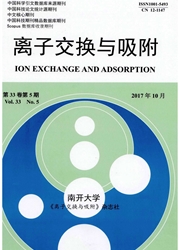

 中文摘要:
中文摘要:
以棕榈纤维为原材料、磷酸为活化剂制备活性炭纤维,通过单因素实验和正交实验深入探讨反应条件对活性炭纤维吸附性能的影响,并确定最佳制备条件。系统研究三氯生在活性炭纤维上的吸附热力学、动力学以及溶液pH值对吸附的影响,并研究比较乙醇洗脱与加热煅烧法对吸附饱和后的活性炭纤维的再生效果。结果表明,磷酸溶液质量分数和碳化温度对活性炭纤维吸附性能影响较大,活化剂浸渍时间对其影响较小,活性炭纤维的最佳制备条件为:磷酸溶液浓度25%,碳化温度400℃,活化时间36h。所制备的活性炭纤维的BET比表面积为1358.478m^2/g、微孔面积为1240.131m^2/g、平均孔径为1.886nm。活性炭纤维对三氯生的吸附等温线符合Langumuir方程,吸附是放热反应。动力学研究表明,吸附反应符合准二级动力学方程,且在5h后基本达到平衡。随着pH值的升高,材料对三氯生的吸附量略有下降。乙醇洗脱和加热煅烧均可有效再生吸附饱和后的活性炭纤维。
 英文摘要:
英文摘要:
In this study, activated carbon fiber was prepared from palm fiber by phosphoric acid activation. Adsorption and desorption behavior and mechanic of triclosan were systematically investigated. The activator concentration and activation temperature had a significant impact on its adsorption capacity while the activation time had little effect on its adsorption capacity. By using Design-Expert and BBD method, the optimum preperation conditions were confirmed (H3PO4 of 25%, activation temperature of 400℃and activation time of 36h). The product prepared under above conditions had the BET surface area of 1358.478m^2/g, micropore area of 1240.131m^2/g and average pore diameter of 1.886. Adsorption isotherms could be well fit by Langnmuir model and the adsorption of triclosan was an exothermic process. The adsorption reached equilibrium after 5h and the Pseudo-second-order equation could fit the experiment kinetic data. With the increase of pH, the adsorption capacity slightly decreased. Ethanol and high temperation calcination could effectively regenerate the adsorbent.
 同期刊论文项目
同期刊论文项目
 同项目期刊论文
同项目期刊论文
 期刊信息
期刊信息
